
What is a Competency?
What is a competency? The fusion of job-relevant knowledge, skills and their correct application to deliver a valued result. This page traces the concept’s evolution—educational standards, behavioral repertoires and organizational capabilities. It outlines Centranum’s operational definition and taxonomy of competency types – based on decades of research in I/O Psychology – (values-based, core, leadership, role-specific and meta competencies). Read on for links to deep dive resources include Business Case, A-Z glossary, competency versus capability versus competence versus certification, free e-books – developing competency statements, competency models, competency assessment.
The competency concept
There are many definitions of “competency” but none universally in use or accepted.
In dictionaries ‘competency’ is defined as a noun – the ability to do something successfully or efficiently.
Synonyms listed include competence, capability, capacity, ability, proficiency, accomplishment, adeptness, adroitness, knowledge, expertise, skill, mastery, talent, aptitude, savvy, know-how.
Some ‘experts’ try to distinguish between skills and competencies, and in the process provide an example of the pervasive conceptual confusion in this arena.
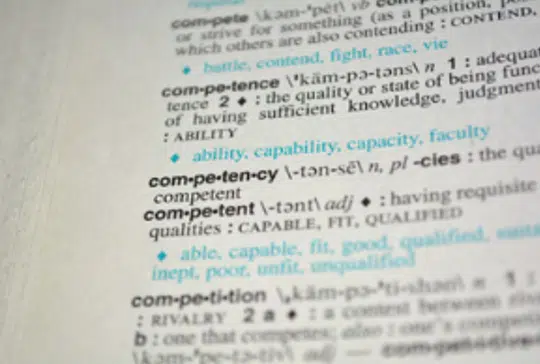
Even though words are given as competency synonyms they do fall into different categories or concepts;
- Potential– capability, capacity, ability, talent, aptitude – the potential is there but may not be used.
- Knowledge– savvy, know how, expertise – what a person knows
- Skills– adeptness, adroitness, expertise, skill – what a person can do
- Outputs– accomplishment – the results achieved
- Proficiency– competence, mastery – refer to levels of competency
In order to use the Competency concept effectively it is essential to have cohesive competencies definitions, used consistently. If not, as the eminent researcher Sparrow pointed out back in 1995, HR will try to “build and integrate HRM systems on a bed of shifting sand”.
If you need a clear set of competency definitions download our A-Z Glossary of Competency Management
The Evolution of the Competency Concept
Those using the competency concept come from 3 different perspectives;
- Educational standards
- Behavioural repertoires
- Organizational competencies
All of these approaches have validity if used in the right context.
Competency as Educational Standards

Obviously from the educational field, but there are different approaches in the USA versus the UK.
In the US ‘competencies’ were derived from functional role and task analysis. They described knowledge, skills and attitudes, or both, required for role or task performance. Assessment was by a ‘criterion’ often a behavioural standard.
In the UK the educational approach was led by industry bodies especially those requiring trades and technical skills. They developed standards of occupational ‘competence’ based on expected work outcomes.
A ‘competence’ was defined as an action, behaviour or outcome to be demonstrated, or a minimum standard. Different levels of mastery were defined by different statements.
This approach is useful for technical, functional and clinical competencies definitions.
Competencies as Behavioural Repertoires
In 1973 David McClelland, working in the educational field in the US, wrote a paper suggesting that personal competencies, which he defined as motives and personality traits, are a better means of predicting occupational success than traditional psychometrics such as IQ and aptitude tests.
Despite the huge body of research that disproves this suggestion, his work was enormously influential. He suggested that it is possible to identify the factors associated with individual success and then teach them to others.
In 1980 McClelland and a colleague, Boyatzis developed a methodology for identifying competencies, based on the skilled behavioural repertoires of star performers in the work context
Their definition of competencies;
“a generic body of knowledge, motives, traits, self images and social roles and skills that are causally related to superior or effective performance in the job.”

A behaviour focused approach can be used in defining core and leadership competencies which are more about interpersonal relationships and cognitive skills.
Organizational Competencies
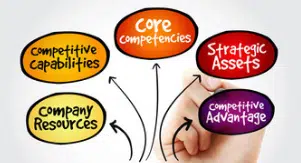
Organisational core competencies can be analysed to identify the required contributing competencies of individuals. It has been suggested that key success factors and core competencies are synonyms.
The competency concept was adopted by business strategists in the late 1980s. In 1989 Hamel and Prahalad famously advanced the idea that Core Competencies the collective learning of an organization, are a competitive advantage. An organization’s core competencies are what differentiate it from the other competitors in its industry. Examples: Kmart – Value Pricing, Toyota – Reliability.
They are also the resources and capabilities that allow the company to achieve profitability.
They are measured at the organisational level.
Iceberg Model
The Iceberg model provides a theoretical base for differentiating competency types. According to this model the top of the iceberg competencies are directly observable knowledge and skills, while those beneath the surface are cognitive, emotive, motivational,trait and self-concept based competencies, often termed meta competencies.
There is often reference to Technical versus Soft skills in the business and consulting media. Broadly speaking technical skills are task related observable knowledge and skills, whereas soft skills are observable interpersonal, leadership and problem solving skills as well as the hidden trait based competencies. (meta competencies)
In the healthcare field a distinction is made between procedural competencies – for example activities using equipment, protocols and interpersonal relationships, and meta-competencies, the cognitive side, for example critical thinking and reflection on one’s own understanding and practice.
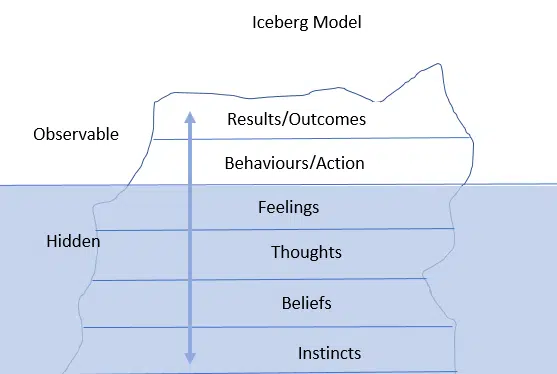
Other Models
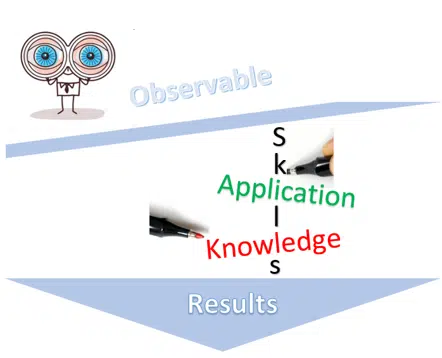
To be of practical use, the essence of a competency must be observable. Motives, personality, ability are not directly observable. So we focus on knowledge and skill and their application on the job – all of which can be observed and measured. The measure being the definition of competence.
In complex roles a certain amount of knowledge, of basic principles, is a precondition of actions (skills).
The organisation needs more than ‘best efforts’. Using competencies as an HR strategy must lead to results – accomplishments – that are valuable to the organisation.
Competency initiatives in organisations must be job relevant, not just obviously desirable generalities – a typical example of such a platitude; ‘Supports shared purpose and direction’.
Competency Types
Defining competencies in practice
Competencies can be categorised according to their purpose and the environment in which they are observed.
From the broadest to the narrowest scope;
These Competencies are primarily concerned with the social domain.
- Values-based Competencies – those which are used to communicate a common purpose and approach in achieving the organisation’s goals. A frequently used example is ‘Integrity’.
- Core Competencies – these describe the way in which people go about their work – the key non task specific or ‘citizenship’ behaviours that the organisation expects. Examples are ‘Team Work’, ‘Collaboration’, ‘Communication’.
- Leadership Competencies – what is expected of leaders at various levels, including the individual contributor. Examples are ‘Innovation’, ‘Personal Leadership’ , ‘Building Relationships’.
These competencies cover professional disciplines, use of equipment and work procedures.
- Role specific competencies – typically called functional or technical or clinical competencies. Examples are Cost Analysis in the Procurement environment, Contract Negotiation for Sales.
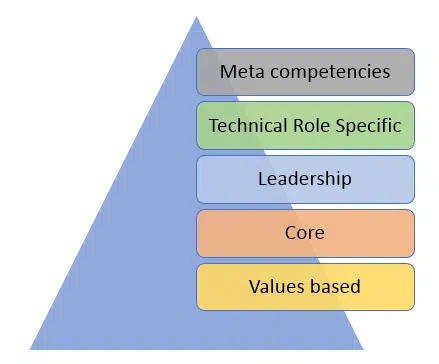
These competencies are vital for personal development; learning, adaptability and creativity.
- Meta Competencies – Cognitive competencies that enhance personal performance, the understanding and awareness of one’s own mental; perceptual, emotional or cognitive processes. Examples – critical thinking and reflection.
Why competencies?
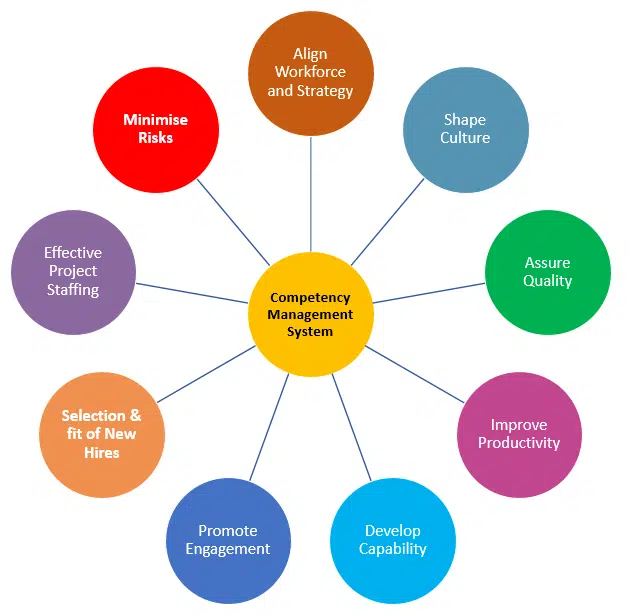
The competency literature includes a huge range of claimed benefits specific to HR processes in organisations.
These include;
- improved recruitment and selection practices through identification of required competencies;
- improved individual organisational and career development programmes through focus on competency based career paths
- improved performance management processes due to communication of expectations and assessment of values based behaviours and core competencies.
- a common language enabling better communication on strategic and HR issues.
Studies have found competencies of all types to have some correlation with individual and organisational performance.
However it is technical job specific competencies and cognitive competencies that reliably predict better job performance.
Challenges of the Competency Approach
There are a number of challenges in developing a Competency Library.
Scope
Eventually the library should cover;
- the behaviours expected to sustain the values of the organisation – that are applicable to all.
- core and leadership competencies that may vary by role and level – examples
- Job specific competencies for all roles
It is best to prioritise and roll the library out in phases.
Getting started
There are several approaches to competency development;
- Purchase and use a proprietary library
- Purchase and adapt a proprietary library
- Develop a competency library specific to your organisation
Ideally organisations develop their own libraries to ensure alignment with their values, language and terminology and relevance to the work of individuals.
Defining Competencies
To do this requires an ‘operational definition’ – a statement that is completely unambiguous. This is especially important for statements relating to ‘generic’ competencies – usually core and leadership competencies. Here research clearly shows that vague statements will lead to subjective assessments based on the overall impression the assessor has of the person being assessed. Competency statements that work.
Validating competencies
It is essential that the competencies in the library are validated. There are several kinds of validity.
- Are the competencies actually describing/measuring what we want to measure.
- Are the competencies able to be measured reliably – everyone has the same interpretation – the ruler (definition of competence) doesn’t change from assessor to assessor.
- Are the competencies important for achievement of the organisation’s aims and strategy. Does a high level of competence predict better organisational outcomes.
